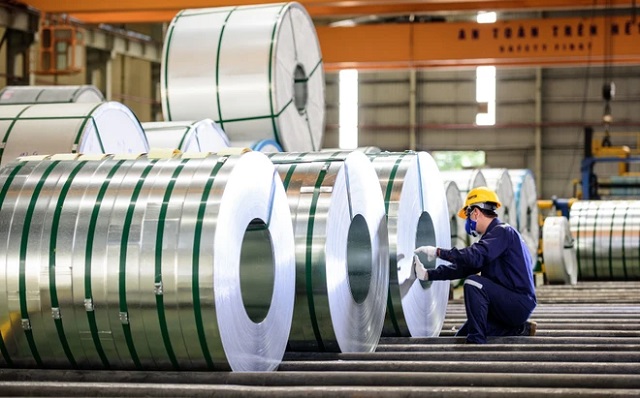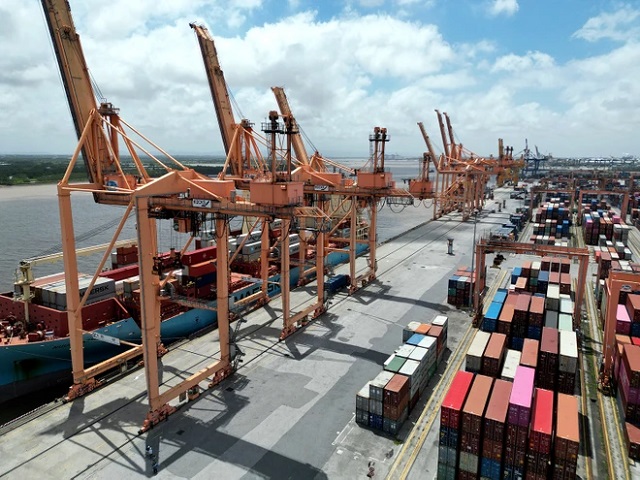
Technology investment business, increasing export value. (Photo: Duc Duy/Vietnam+)
|
Participating in free trade agreements (FTAs) has helped Vietnam become one of the major suppliers of goods in the world, but the increase in anti-evasion trade remedy investigations is also putting pressure on businesses.
Therefore, in addition to early warnings from relevant agencies about goods and industries at high risk, improving knowledge and meeting the standards of importers is one of the important solutions to help businesses proactively cope with and minimize losses when exporting to international markets.
Rapid increase in the number of trade remedy cases
On March 8, 2024, the Canada Border Services Agency (CBSA) initiated an investigation into the application of anti-dumping measures for steel wire originating or exported from Vietnam.
Up to now, Canada has initiated 08 trade remedy investigations against Vietnam’s steel exports, including 05 cases of anti-dumping investigation, 02 cases of countervailing investigation, and 01 case of safeguard investigation.
Specifically, Canada is targeting most of Vietnam’s main steel export products such as concrete reinforcing steel, corrosion-resistant steel plate, rolled steel, OCTG steel pipes, and so on. The absolute increase in value is one of the criteria for Canada to conduct investigations and impose trade remedy measures on Vietnam’s steel wire.
Not only Canada, but there have also been more than 70 trade investigations impacting steel exports from Vietnam to other countries (such as anti-dumping, countervailing, anti-evasion measures) from 2004 to now.
It is worth noting that Mr. Pham Cong Thao, Deputy General Director of Vietnam Steel Corporation (VNSteel), shared that under the new regulations effective from July 1, 2023 of the EU, the bloc will continue to maintain safeguard measures against steel imported into the EU until June 30, 2024. Therefore, to qualify for exemption from safeguard duties, Vietnam must maintain the export proportion below 3% of the EU’s total imports for each product, and if it exceeds the quota, it must pay an import duty of 25% for the exceeded portion.

Export of steel sheets by Hoa Sen Group. (Photo: PV/Vietnam+)
|
For the Aluminum industry, there were also 4 trade remedy cases in 2023 that put a lot of pressure on Vietnamese businesses. Mr. Vu Van Phu, Vice Chairman cum General Secretary of the Vietnam Aluminum Association, shared that the EU and the United States continuously apply trade remedy measures. In 2023, the United States filed a lawsuit against Vietnam’s aluminum and proposed a tariff of 53.7%, which will be very difficult for businesses to maintain their market share.
“The association has disseminated to businesses the need to actively equip themselves with full knowledge of trade remedies and use trade remedy measures as a tool to protect their industry and businesses,” said Mr. Vu Van Phu.
Ensuring traceability of origin
According to statistics from the Vietnam Chamber of Commerce and Industry (VCCI), in the past 6 years (from 2017 to 2023), the number of trade remedy cases has increased much faster than in previous periods.
The number of trade remedy cases that Vietnamese exports have faced in foreign markets accounts for over 52% of the total number of trade remedy cases that Vietnam has faced in over 30 years. It is estimated that the number of cases of anti-evasion trade remedy measures that Vietnam has been sued for from 2017 to now accounts for nearly 60% of the total number of anti-evasion lawsuits that Vietnam has faced so far.
Ms. Nguyen Thu Trang, Director of the WTO and Integration Center, Vietnam Chamber of Commerce and Industry (VCCI), assesses that in the late 90s and early 2000s, the main products being sued were products with large export turnover and strengths in exports or key export products, such as seafood and footwear. However, recently, the number of products and industries being sued for trade remedies has expanded much more, with nearly 40 products being sued for trade remedies, including products with not very large export turnover.
In addition, previously only key export markets were sued for trade remedies, but now other markets, including new markets, also account for a large proportion of trade remedy cases. Specifically, among a total of 235 cases as of August 2023, the United States accounted for 23% of cases, India accounted for 14%, Turkey accounted for 10%, followed by Canada, the EU, the Philippines, Indonesia.
Although products such as iron, steel, or aluminum are not the focal export products of Vietnam, according to VCCI, they are the most concentrated group of products facing trade remedy lawsuits worldwide, so Vietnam also bears the impact of trade remedies.
On the other hand, some Vietnamese products are increasing their competitiveness and putting pressure on domestic industries in export markets (through taking advantage of tariff incentives through free trade agreements) or because Vietnam is improving its capabilities, so those products are also at risk of being sued for trade remedies.
“Early warnings help us recognize risks and prepare from the very beginning when we see the first signs. This will give businesses more conditions and minimize losses,” recommended Ms. Trang.
 Exported goods of Vietnam. (Photo: Duc Duy/Vietnam+)
|
The essence of trade remedies is to target unfair competition of imported goods or due to the sudden increase in import volume that cannot be foreseen. Based on that, the importing country will apply corresponding measures.
Mr. Do Ngoc Hung, Commercial Counselor, Head of Vietnam Trade Office in the US, believes that to increase sustainable production and export capacity, businesses need to consider investing in research to increase the value of products, reduce dependence on price competition while shifting to compete in terms of quality and technology, and ensure traceability of input materials for product manufacturing.
Meanwhile, Mr. Chu Thang Trung, Deputy Director of the Trade Remedies Authority (Ministry of Industry and Trade), also advised businesses to study and understand basic information and knowledge about trade remedies to understand the rights and obligations of businesses in trade remedy cases, such as: domestic laws on trade remedies; common investigative principles and application of trade remedies worldwide as reflected in the agreements of the World Trade Organization…
Regarding the Trade Remedies Authority, based on information from the early warning system, the Authority will focus on this work and concentrate on sectors and areas at high risk, as well as coordinate with units and localities to organize knowledge and information sharing sessions about trade remedies and the early warning system to increase awareness for the business community, Trade Associations, thereby actively participating in investigations (if any).
Duc Duy











